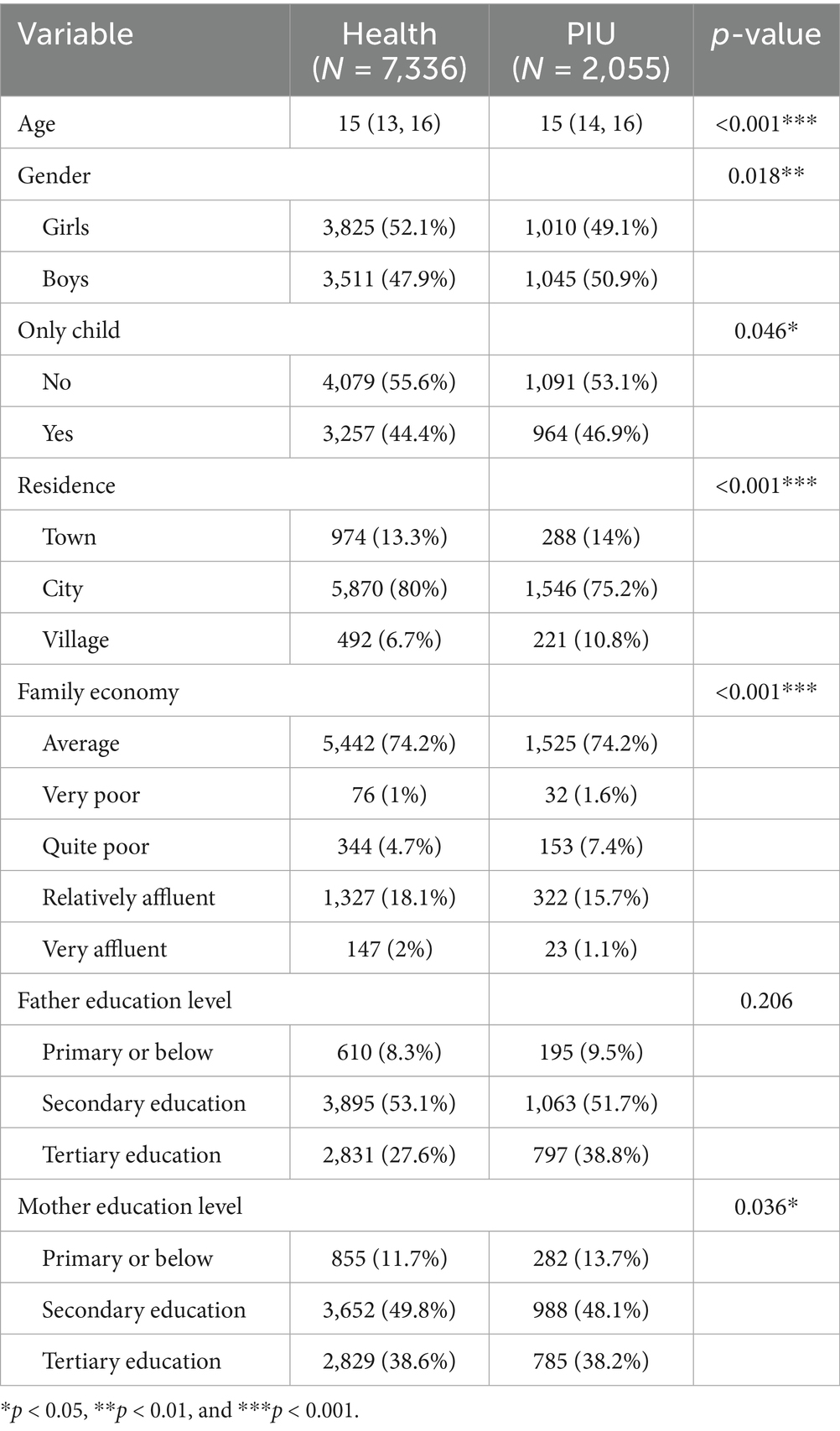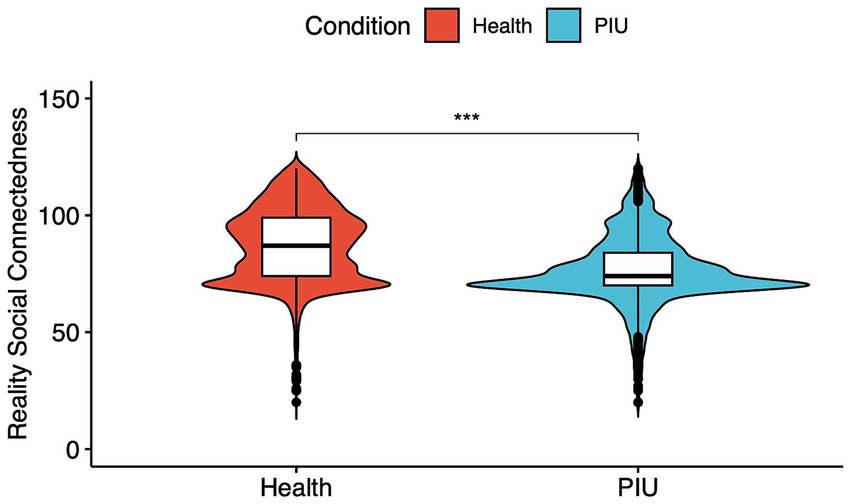- 1The Mental Health Center, West China Hospital, Sichuan University, Chengdu, China
- 2Psychiatric Laboratory, West China Hospital, Sichuan University, Chengdu, China
- 3Department of Neurobiology, Affiliated Mental Health Center & Hangzhou Seventh People’s Hospital, Zhejiang University School of Medicine, Hangzhou, China
- 4NHC and CAMS Key Laboratory of Medical Neurobiology, MOE Frontier Science Center for Brain Science and Brain-Machine Integration, School of Brain Science and Brain Medicine, Zhejiang University, Hangzhou, China
Introduction: Problematic internet use (PIU) has become a prevalent concern worldwide and is associated with increased aggression. However, the underlying effect of PIU on aggression remains unclear. In this study, we aimed to investigate the potential influence of reality social connectedness (RSC) on the relationship between PIU and aggression.
Methods: We used cross-sectional data from a large survey conducted among middle school students in four provinces of China between September 2022 and March 2023. PIU, RSC, and aggression were assessed using Young’s 20-item Internet Addiction Test (IAT-20), the modified Social Connectedness Scale-Revised (SCS-R), and the Buss–Perry Aggression Questionnaire (BPAQ), respectively.
Results: We found that students who experienced PIU had significantly higher scores on the BPAQ, which reflects the aggression levels, compared to students without PIU. Specifically, all four dimensions of aggression—verbal aggression, physical aggression, hostility, and anger—were elevated in the PIU group. Additionally, RSC was significantly reduced among individuals with PIU. Notably, RSC significantly mediated the relationship between PIU and aggression, accounting for 18.89% of the total effect. Among the four dimensions of aggression, the mediating effect of RSC was strongest for hostility, followed by anger and physical aggression, with the weakest observed for verbal aggression.
Discussion: RSC significantly mediated the relationship between PIU and aggression, suggesting that reduced RSC partially explains how PIU exacerbates aggression. This result highlights the importance of fostering RSC as a strategy to reduce aggression related to PIU.
1 Introduction
Problematic internet use (PIU), often referred to as internet addiction, has become a prevalent concern in modern society, particularly among adolescents. The extensive use of the internet for various activities, including social media, online gaming, and browsing, has been linked to various psychological and behavioral issues (1–3).
Previous studies have shown a potential link between PIU and aggression (4–8) across various locations and cultures, highlighting this phenomenon as a universal issue. Aggression, which includes behaviors such as physical aggression, verbal aggression, hostility, and anger (9), represents a significant social problem, particularly among adolescents. Adolescence is a period of rapid psychosomatic development and identity formation, influenced by unique sociocultural factors. During this period, adolescents often face emotional instability and are prone to impulsivity (10), which can exacerbate aggressive thoughts and behaviors (11), creating challenges for not only the individuals themselves but also for those around them. The relationship between PIU and aggression is complex and multifaceted, influenced by various social and psychological factors (4, 7, 12). Although bidirectional influences between PIU and aggression have been reported, recent longitudinal studies mainly focused on the negative impact of PIU and indicated that excessive internet use typically precedes increases in externalizing behaviors (13, 14). A typical Interaction of Person-Affect-Cognition-Execution (I-PACE) model also posits dysregulated internet use as an upstream factor (15). However, further mechanisms underlying PIU and aggression were unclear. Identifying potential mediators in the direction from PIU to aggression is crucial, as it may provide important insights for interventions and guide future research.
Social connectedness, defined as “the sense of belonging and subjective psychological bond that people feel in relation to individuals and groups of others (16),” is fundamental to human beings. Previous studies have shown its positive effect on life expectancy (17–20). Additionally, social connectedness has been linked to reduced depression (21, 22) and a lower risk of cognitive decline in older adults (23). Notably, one study reported a decrease in social connectedness among individuals with PIU (24). Furthermore, increased social connectedness has been shown to reduce aggression (25, 26).
With the widespread use of the internet, online communities have gradually evolved into virtual societies. Consequently, a sense of virtual social connectedness has emerged, which is distinct from reality social connectedness (RSC) (27, 28). However, the commonly used Social Connectedness Scale (SCS), originally developed before the widespread adoption of the internet (prior to 2000), does not account for this distinction (29). As a result, previous studies did not distinguish between reality and virtual social connectedness.
Given this gap, our study aimed to investigate the role of RSC in the relationship between PIU and aggression among Chinese middle school students. We hypothesized that RSC would mediate the relationship between PIU and aggression, and this mediating effect would vary across four subtypes of aggression (physical aggression, verbal aggression, hostility, and anger). Understanding this underlying mechanism may provide a new insight into interevent the aggression with PIU.
2 Methods
2.1 Participants
Data for this study were derived from a large cross-sectional study that employed a convenience sampling approach among middle school students in four provinces of China—Fujian, Jiangsu, Sichuan, and Xinjiang—representing the eastern, southern, western, and northern regions, respectively (30). Briefly, one or two middle schools were selected from each province following consultation with local education bureaus. All students aged 12 to 19 years whose parents and themselves signed informed consent were then asked to complete an anonymous online questionnaire.
The inclusion criteria for this study were as follows: (1) adolescents aged 12–19 years who were enrolled in school during the study, and (2) adolescents who provided clear responses to all questionnaire items. The exclusion criteria were: (1) participants who completed the questionnaire survey in less than 10 min, (2) participants who submitted multiple survey questionnaire responses, and (3) participants who responded, “completely untrue” or “untrue” to the final item assessing response validity: “To what extent does your survey reflect your actual situation?”
Ethical approval for this study was obtained from the Ethics Committee of West China Hospital, Sichuan University (No. 2019-907).
2.2 Measurements
2.2.1 Sociodemographic information
Sociodemographic information was collected for all participants, including age (in years), sex (boys/girls), place of residence (city/town/rural), self-reported subjective family economic situation (very poor/relatively poor/average/economically well off/economically well off), whether they were from an only-child family (yes/no), and the parents’ education level (illiterate/primary school/middle school/high school/technical secondary schools/junior college/bachelor/master/doctor).
2.2.2 Assessment of PIU, aggression, and RSC
PIU was assessed using Young’s 20-item Internet Addiction Test (IAT), a widely used self-assessment scale (31). Each item is rated on a 5-point Likert scale ranging from 1 = “never,” 2 = “seldom,” 3 = “sometimes,” 4 = “often,” to 5 = “very often.” All items were summed to create the IAT score, yielding a score range from 20 to 100. The higher the score on the scale, the stronger the state of PIU exhibited by the subject. In this study, we set the threshold for PIU based on previous research, defining it as the IAT score equal to or greater than 50 points (32). In this study, Cronbach’s α was 0.937.
RSC was measured by the SCS-Revised (SCS-R) with a little modification, which contains 20 6-point Likert items (29). Compared to the raw version of SCS-R, we added the prompt “in the real world” to the questionnaire and increased the font size and boldness of the text to ensure effective communication with participants. During the total score calculated, items 3, 6, 7, 9, 11, 13, 15, 17, 18, and 20 are reversed scored. The total score (range from 20 to 120) was calculated, as a higher score means that participants have higher RSC with others. In this study, Cronbach’s α was 0.902. An exploratory factor analysis (EFA) was conducted, yielding a Kaiser–Meyer–Olkin (KMO) measure of sampling adequacy of 0.951, indicating excellent suitability for factor analysis. The cumulative variance explained by the extracted factors was 64.3%.
Aggression was measured using the Buss and Perry Aggression Questionnaire (9) (BPAQ), developed by Buss and Perry in 1992, which includes 29 items covering the four domains—physical aggression, verbal aggression, anger, and hostility. Items were scored on a 5-point Likert scale from 1 = “very non-compliant” to 5 = “very compliant,” with higher scores implying more aggressive behaviors. Physical aggression was calculated from questions 2, 5, 8, 11, 13, 16 (reverse scored), 22, 25, and 29; verbal aggression was derived from questions 4, 6, 14, 21, and 27; anger was obtained from questions 1, 9 (reverse scored), 12, 18, 19, 23, and 28; and hostility was derived from questions 3, 7, 10, 15, 17, 20, 24, and 26. The total score of BPAQ can reflect the overall aggression level of the subjects. In this study, Cronbach’s α was 0.917.
2.2.3 Data analysis
For categorical variables, we used the frequency and percentage to show the result. For continuous variables, we used the Anderson–Darling test to detect whether the normal distribution is satisfied or not. The continuous variables following the normal distribution, the mean, and standard deviation (mean ± SD) were reported; otherwise, median and interquartile (IQR) will be reported.
Partial correlations between variables were calculated, with age and gender included as control variables. To better understand the relationship between PIU and aggression, especially for exclude the potential confounding factors, we employed hierarchical line regression. First, univariate linear regression was used to find out the potential associated with aggression. Then those factors were taken into the hierarchical linear regression. In step 1, the PIU status was set as the independent variable, and the BPAQ total score was set as the dependent variable. In step 2, we introduced adjusted variables, including sex, age, place of residence, parents’ education level, and self-reported family economic situation. Categorical variables, such as gender, place of residence, parents’ education level, and self-reported family economic situation, were represented using dummy variables. Finally, RSC was added to the regression model. In the regression analysis, the 95% confidence intervals were included, and both the R2 and adjusted R2 were calculated.
To evaluate the role of RSC in relationship between RSC and aggression, mediation analysis was performed using the bruceR (33) package, which is based on the mediation package in R (34). Mediation analysis helped determine whether the relationship between independent variables and dependent variables is through an indirect way. The PIU status was set as the independent variable, and the BPAQ total score and its four dimensions—physical aggression, verbal aggression, anger, and hostility—were set as the dependent variables separately. The RSC was set as the moderator variable. During mediation analysis, age, gender, residence, family economy, and adjusting for sociodemographic factors based on the results obtained from the previous hierarchical analysis were set as the co-variables.
Visualization of the data was performed using the R package “ggpubr” (35). All data analysis were produced by the RStudio (Version 2023.06.2 + 561, ©2009–2019 RStudio, Inc., Boston, MA, USA) with R (version 4.3.1) (36).
3 Results
3.1 Sample characteristics
A total of 11,945 questionnaires were collected. After excluding 2,057 low-quality responses and 480 participants who did not meet the age criteria, 9,391 (4,556 boys and 4,835 girls) valid questionnaires remained. About 21.89% of middle school students were PIU participants according to the IAT test. Significant differences were observed between the PIU group and the health group regarding sex, only-child status, residence, family economy, and mother’s educational level (Table 1).
3.2 Correlation among aggression, PIU, and RSC
With regard to the health group, the total aggression scores of the PIU group were significantly higher [median (IQR) 61.0 (48.0 to 74.0) vs. 83.0 (70.0 to 91.0), p < 0.001]. Analysis of subsequent subscales indicated that the PIU participants showed significantly higher in four dimensions. Among PIU participants, the median (interquartile) scores for physical aggression, verbal aggression, anger, and hostility were 23.0 (18.0 to 27.0), 15.0 (13.0 to 17.0), 20.0 (16.0 to 23.0), and 24.0 (21.0 to 28.0), respectively. In contrast, among healthy individuals, the corresponding median (interquartile) scores were 16.0 (13.0 to 21.0), 12.0 (9.0 to 15.0), 14.0 (11.0 to 18.0), and 18.0 (13.0 to 23.0), respectively (Figure 1).
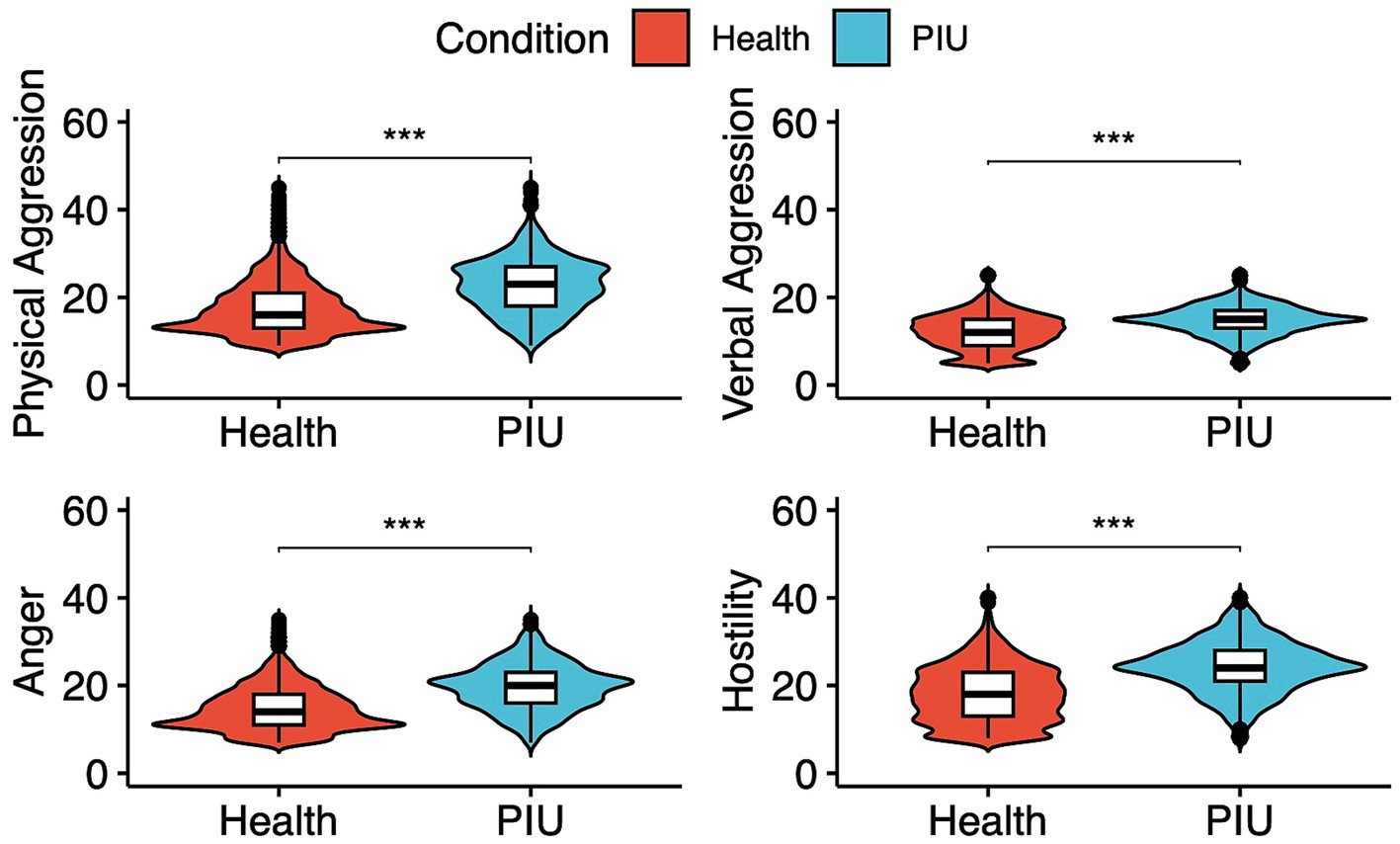
Figure 1. Four dimensions of aggression in PIU and healthy adolescents. *p < 0.05, **p < 0.01, and ***p < 0.001.
In assessing the RSC, the scale indicated weaker RSC among PIU adolescents than healthy adolescents [median (IQR) for healthy adolescents: 87.0 (74.0 to 99.0); median (IQR) for PIU adolescents: 74.0 (70.0 to 84.0), p < 0.001; Figure 2].
Furthermore, the partial correlation shows a positive correlation between the IAT score and aggression including the total score of BPAQ and four subscales, such as physical aggression, verbal aggression, anger, and hostility (Figure 3).
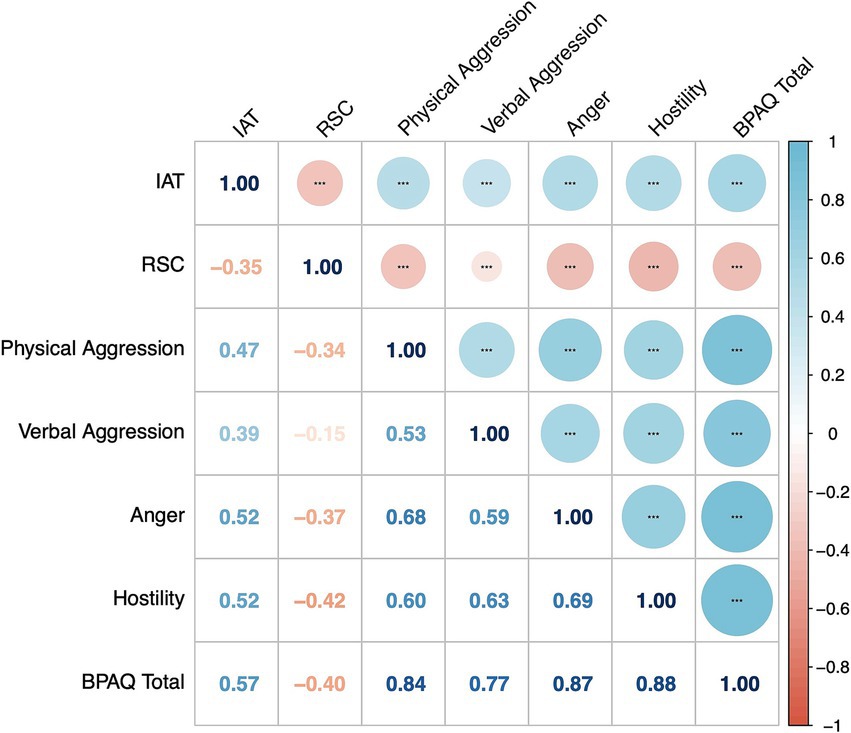
Figure 3. The partial correlation results among the IAT, BPAQ, and RSC The partial correlation scores were presented. IAT, the score of the Internet Addiction Test (IAT-20) which measured the severity of internet use; RSC, reality social connectedness. *p < 0.05, **p < 0.01, and ***p < 0.001.
To explore the quantitative relationship between PIU and aggression, we conducted both univariable regression and multivariable hierarchical regression analyses. The univariable regression showed that the age, gender, residence, and parents’ educational level were significantly correlated with the BPAQ total score (Table 2). Therefore, these variables were included as control factors in the following multivariable analyses.
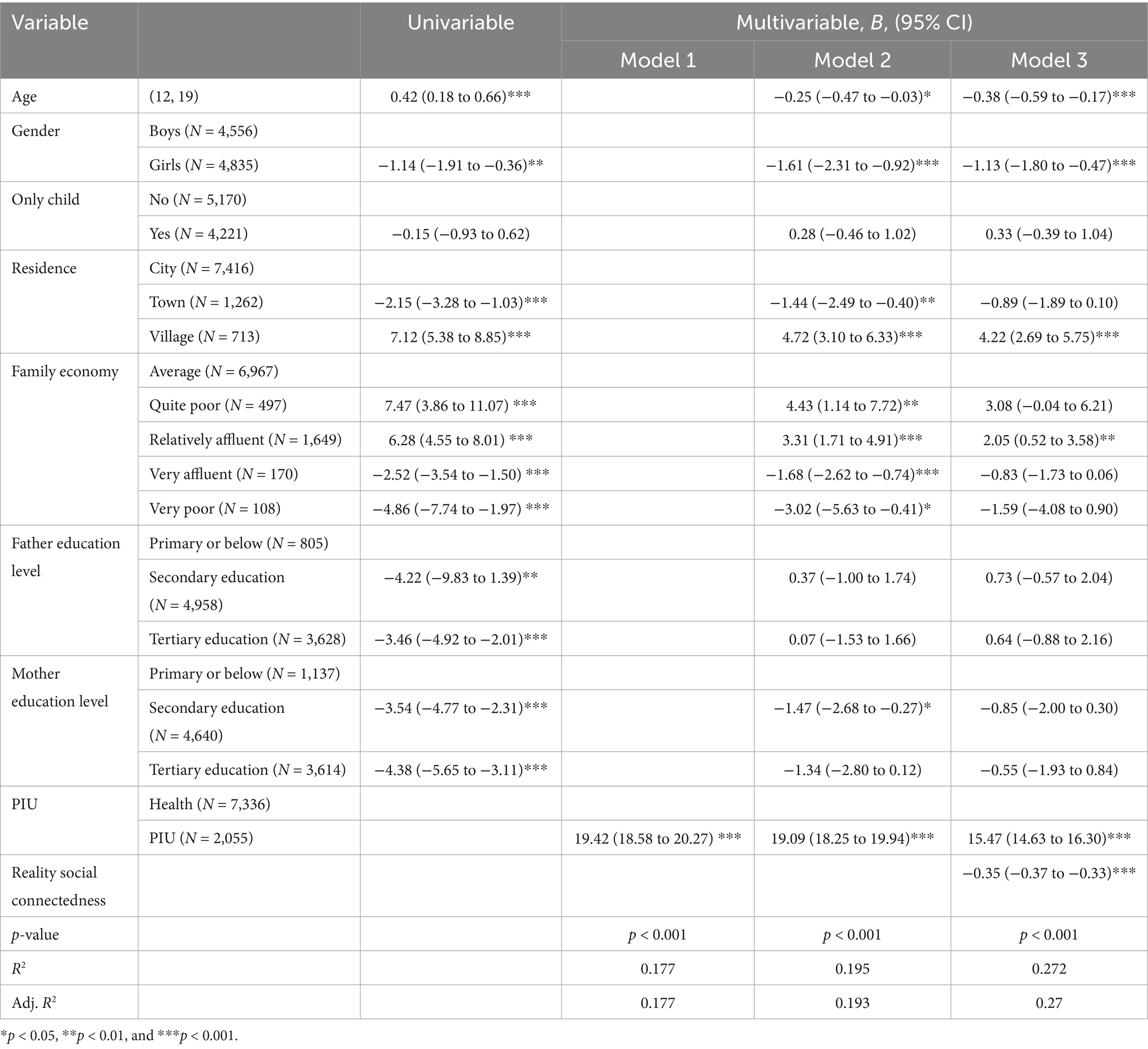
Table 2. Hierarchical regression evaluating RSC as moderator of the relationship between PIU and aggression.
The hierarchical regression showed the impact of individual factors (Table 2). The PIU status was set as the independent variable, whereas the BPAQ total score was set as the dependent variable. In Model 1, PIU explained 17.7% of the variance in the BPAQ total score. Model 2 incorporated basic sociodemographic variables into the analysis, resulting in a modest increase in explanatory power (adjusted R2 = 0.193, ΔR2 = 0.016). Model 3 introduced RSC into the linear model, revealing a 1.6% contribution to the BPAQ total score (R2 = 0.272, adjusted R2 = 0.270, and ΔR2 = 0.077). Notably, the RSC showed a negative modulated aggression arising from PIU (B = −0.35, 95% CI = −0.37 to −0.32, p < 0.001), consistent with the previous partial correlation result.
3.3 RSC as a mediator between the PIU and aggression
To explore the potential mediation effect of RSC on the relationship between PIU and aggression, we used the mediation analysis (Figure 4A). We found a significant direct effect [β = 0.336, SE = 0.009, 95% CI (0.317, 0.354)] and indirect effect [β = 0.078, SE = 0.004, 95% CI (0.071, 0.086)] when RSC was analyzed as a mediation variable. The mediating effect accounted for 18.84% for the total effect.
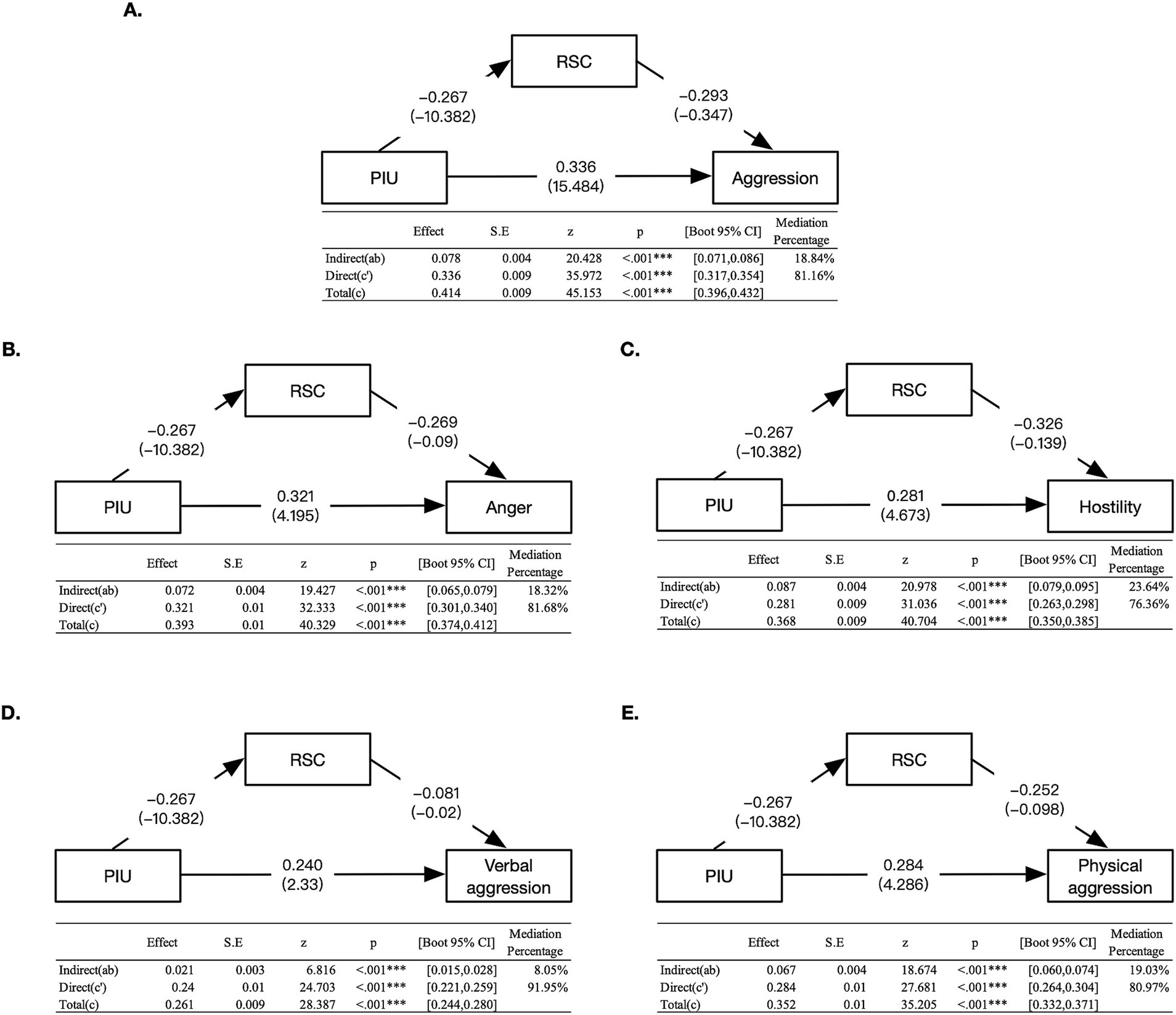
Figure 4. Mediation model with standardized and unstandardized coefficients. The mediation effects of RSC on the relationship between PIU and (A. aggression, B. Anger, C. Hostility, D. Verbal aggression, E. Physical aggression). Several variables such as age, sex, residence, family economic status was set as covariates in mediation effects analysis. Standardized coefficients (β) are reported, with unstandardized coefficients (B) presented in parentheses. All 95% confidence interval [CI] was calculated using 5,000 bootstrap replicates. PIU, problematic Internet use; RSC, reality social connectedness; CI, confidence interval. *p < 0.05, **p < 0.01, and ***p < 0.001.
To examine the specific contributions of aggression subtypes, we used the four subscales of the BPAQ—anger, hostility, verbal aggression, and physical aggression—as independent variables to model the indirect effects of RSC (Figures 4B–E). Consequently, RSC showed the significant indirect effects: anger β = 0.072, 95% CI (0.065, 0.079), SE = 0.004; hostility β = 0.087, 95% CI (0.079, 0.095), SE = 0.004; verbal aggression β = 0.021, 95% CI (0.015, 0.028), SE = 0.003; and physical aggression β = 0.067, 95% CI (0.060, 0.074), SE = 0.004. The mediation effect of RSC could explain the highest proportion to hostility (23.64%), followed by the physical aggression (19.03%), anger (18.32%), and verbal aggression (8.05%).
4 Discussion
First, our study demonstrated a significant association between PIU and aggression, encompassing the four subtypes: anger, hostility, physical aggression, and verbal aggression. Second, RSC was negatively correlated with both PIU and anger. Finally, mediation analysis revealed a significant mediating effect of RSC in the relationship between PIU and aggression.
Significant correlations were found between IAT, which reflected the severity of PIU, and aggression including the four subtypes. This result is consistent with an Israeli study that found a positive relationship between internet addiction and aggression (4). Similar results have been found in other studies (7, 37, 38). Collectively, these studies suggest that PIU may foster aggression across various cultures and economic situations. The internet world provides a virtual anonymous world that the moral constraints on aggression are also down (39). Teenagers are more likely to be exposed to impulsive and violent content. Additionally, the community system constructed by the internet breaks down traditional geographic isolation, making it easier to form communities based on shared interests. This system facilitates access to such content, creating a positive feedback loop that further reinforces exposure to and engagement with impulsive and violent materials. This association is particularly concerning given our adolescent sample. Compared with other age groups, adolescents are at their developmental peak while facing identity transitions influenced by unique psychological and social factors. Studies have found that physical aggression tends to rise during the sixth and seventh grades (40). Additionally, one study highlights that physical aggression reaches its peak at age 15, whereas social aggression peaks at age 14 (41). Consequently, the confluence of aggression and PIU among adolescents necessitates heightened attention and targeted intervention strategies.
Our findings show that RSC significantly mediates the relationship between PIU and aggression points to the protective role of RSC. Previous studies have shown that RSC can alleviate aggression, which is consistent with other studies (42–44). The basic mechanism of indirect effect (PIU → RSC → aggression) is that, as PIU increased, individuals spend less time on realistic socializing, leading to a reduction in RSC. This decline in RSC would weaken the RSC’s protection against aggression (43). Beyond that, another potential mechanism underlying this relationship involves emotional regulation. PIU is often associated with negative emotions, especially loneliness, anxiety, and depression (45–48). These harmful negative emotions can lead people to withdraw from real-world communication. When combined with those negative factors, the protective role will be weakened.
Among the four aggression subtypes, RSC exhibited a stronger protective effect against hostility, physical aggression, and anger, but a weaker protective effect against verbal aggression. Types of internet use among adolescents may be a key regulator. Generally, social media and online gaming are the main forms of internet use among teenagers. In China, according to government research, mobile phone is the first choice for accessing the internet among minors (49), and wearable devices, such as smartwatches, are the second choice for accessing the internet. Interestingly, even some of the non-traditional network devices with screens that can access the internet (e.g., smart speakers, smart desk lamps, electronic dictionaries, etc.) have also become a method for minors to access the internet. This may be due to strong parental supervision as well as government regulation, resulting in minors being restricted from accessing traditional online devices. However, these devices are often not capable of running online games due to device performance issues and are more likely to use social media. So, the problems associated with social media may be more pronounced in Chinese adolescents. Given the communication style prevalent on social media platforms, verbal aggression may be particularly dominant among adolescents. Moreover, the anonymity of the web lowers the barriers of verbal aggression (50).
5 Limitation
This study has several limitations. Although we emphasized that the data would be anonymized for this study and participants had the option to submit anonymously, the involvement of schools and guardians may have influenced participants to provide socially desirable responses. Additionally, there are also confounders in this study that may affect further generalization of the results. For example, the study did not include some psychometric indicators such as loneliness, anxiety, depression, etc. It also lacked measurement such as relationships of family members that might influence participant behavior. Good family dynamics can play a protective role in the development of aggression (51), whereas family conflict may exacerbate its development (52).
Although we selected middle school students from four provinces in China, factors such as geographic variation, differences in economic development, and cultural diversity may not capture the full diversity of the Chinese adolescent population. Additionally, the cross-sectional design of this study precludes the establishment of causal relationships. Future research should employ longitudinal designs to better understand the causal pathways between PIU, RSC, and aggression.
6 Conclusion
In conclusion, our findings highlight the aggression associated with PIU, especially among middle school students who are in a special period of mental and physical development. These findings suggest that targeted interventions focusing on enhancing the RSC among adolescents with PIU could potentially reduce aggression. Therefore, school-based activities designed to promote healthy interpersonal relationships, along with social programs aimed at foresting supportive family environments, can serve as effective strategies to prevent aggression in adolescents with PIU. These interventions not only assist in reducing unhealthy online behaviors but also help prevent incidents of adolescent conflict related to internet addiction.
Data availability statement
The data analyzed in this study is subject to the following licenses/restrictions: the data supporting the findings of this study can be obtained upon request from the corresponding author. However, the data are not publicly accessible due to privacy and ethical considerations. Requests to access these datasets should be directed to eHVqaWFqdW4xMjBAMTI2LmNvbQ==.
Ethics statement
The studies involving humans were approved by Ethics Committee of West China Hospital, Sichuan University. The studies were conducted in accordance with the local legislation and institutional requirements. Internet-based digital informed consent for participation was signed from the participants or the participants’ legal guardians next of kin in accordance with the national legislation and institutional requirements.
Author contributions
JR: Conceptualization, Data curation, Software, Writing – original draft. JiaqX: Data curation, Writing – original draft. DL: Writing – review & editing. TL: Supervision, Writing – review & editing. JiajX: Funding acquisition, Supervision, Writing – review & editing.
Funding
The author(s) declare that financial support was received for the research and/or publication of this article. This work was supported by grants from the STI 2030-Major Projects (Grant No. 2021ZD0202105), 1·3·5 projects for Artificial Intelligence of West China Hospital (Grant No. ZYAI24056 and ZYAI24035), and the soft science research program of Sichuan Provincial Department of Science and Technology (Grant No. 2023JDR0341).
Acknowledgments
The authors would like to thank Huiting Luo and Wenxin Bao for data visualization.
Conflict of interest
The authors declare that the research was conducted in the absence of any commercial or financial relationships that could be construed as a potential conflict of interest.
Generative AI statement
The authors declare that no Gen AI was used in the creation of this manuscript.
Publisher’s note
All claims expressed in this article are solely those of the authors and do not necessarily represent those of their affiliated organizations, or those of the publisher, the editors and the reviewers. Any product that may be evaluated in this article, or claim that may be made by its manufacturer, is not guaranteed or endorsed by the publisher.
References
1. Cheng, C, Lau, YC, Chan, L, and Luk, JW. Prevalence of social media addiction across 32 nations: meta-analysis with subgroup analysis of classification schemes and cultural values. Addict Behav. (2021) 117:106845. doi: 10.1016/j.addbeh.2021.106845
2. Mak, KK, Lai, CM, Watanabe, H, Kim, DI, Bahar, N, Ramos, M, et al. Epidemiology of internet behaviors and addiction among adolescents in six Asian countries. Cyberpsychol Behav Soc Netw. (2014) 17:720–8. doi: 10.1089/cyber.2014.0139
3. Elhai, JD, Dvorak, RD, Levine, JC, and Hall, BJ. Problematic smartphone use: a conceptual overview and systematic review of relations with anxiety and depression psychopathology. J Affect Disord. (2017) 207:251–9. doi: 10.1016/j.jad.2016.08.030
4. Agbaria, Q. Internet addiction and aggression: the mediating roles of self-control and positive affect. Int J Ment Heal Addict. (2021) 19:1227–42. doi: 10.1007/s11469-019-00220-z
5. Zhang, Y, Hou, Z, Wu, S, Li, X, Hao, M, and Wu, X. The relationship between internet addiction and aggressive behavior among adolescents during the COVID-19 pandemic: anxiety as a mediator. Acta Psychol. (2022) 227:103612. doi: 10.1016/j.actpsy.2022.103612
6. Haddad, C, Malaeb, D, Sacre, H, Khalil, JB, Khansa, W, Al Hajj, R, et al. Association of problematic internet use with depression, impulsivity, anger, aggression, and social anxiety: results of a national study among Lebanese adolescents. Pediatr Investig. (2021) 5:255–64. doi: 10.1002/ped4.12299
7. Lim, J-A, Gwak, AR, Park, SM, Kwon, J-G, Lee, J-Y, Jung, HY, et al. Are adolescents with internet addiction prone to aggressive behavior? The mediating effect of clinical comorbidities on the predictability of aggression in adolescents with internet addiction. Cyberpsychol Behav Soc Netw. (2015) 18:260–7. doi: 10.1089/cyber.2014.0568
8. Tomska, N, Rył, A, Turoń-Skrzypińska, A, Szylińska, A, Marcinkowska, J, Durys, D, et al. Emotional state of young men in relation to problematic internet use. Int J Environ Res Public Health. (2022) 19:12153. doi: 10.3390/ijerph191912153
9. Buss, AH, and Perry, M. The aggression questionnaire. J Pers Soc Psychol. (1992) 63:452–9. doi: 10.1037/0022-3514.63.3.452
10. Bailen, NH, Green, LM, and Thompson, RJ. Understanding emotion in adolescents: a review of emotional frequency, intensity, instability, and clarity. Emot Rev. (2019) 11:63–73. doi: 10.1177/1754073918768878
11. Carlo, G, Mestre, MV, McGinley, MM, Samper, P, Tur, A, and Sandman, D. The interplay of emotional instability, empathy, and coping on prosocial and aggressive behaviors. Personal Individ Differ. (2012) 53:675–80. doi: 10.1016/j.paid.2012.05.022
12. Kim, EJ, Namkoong, K, Ku, T, and Kim, SJ. The relationship between online game addiction and aggression, self-control and narcissistic personality traits. Eur Psychiatry. (2008) 23:212–8. doi: 10.1016/j.eurpsy.2007.10.010
13. Lin, S, Fabris, MA, Longobardi, C, and Mastrokoukou, S. The association between social media addiction and aggressive behaviors: a longitudinal and gender-specific analysis. J Adolesc. (2025) 97:798–807. doi: 10.1002/jad.12454
14. Zhu, X, Li, W, Zhao, H, and Hu, J. Surfing into trouble? How internet use influences early adolescent behavior through diverse pathways? Humanit Soc Sci Commun. (2024) 11:1413. doi: 10.1057/s41599-024-03956-9
15. Brand, M, Young, KS, Laier, C, Wolfling, K, and Potenza, MN. Integrating psychological and neurobiological considerations regarding the development and maintenance of specific internet-use disorders: an Interaction of Person-Affect-Cognition-Execution (I-PACE) model. Neurosci Biobehav Rev. (2016) 71:252–66. doi: 10.1016/j.neubiorev.2016.08.033
16. Haslam, C, Cruwys, T, Haslam, SA, and Jetten, J. Social connectedness and health In: Encyclopedia of geropsychology. Springer: Singapore (2015). 1–10.
17. Berkman, LF, and Syme, SL. Social networks, host resistance, and mortality: a nine-year follow-up study of Alameda County residents. Am J Epidemiol. (1979) 109:186–204. doi: 10.1093/oxfordjournals.aje.a112674
18. Giles, LC, Glonek, GF, Luszcz, MA, and Andrews, GR. Effect of social networks on 10 year survival in very old Australians: the Australian longitudinal study of aging. J Epidemiol Community Health. (2005) 59:574–9. doi: 10.1136/jech.2004.025429
19. Bennett, KM. Low level social engagement as a precursor of mortality among people in later life. Age Ageing. (2002) 31:165–8. doi: 10.1093/ageing/31.3.165
20. Glass, TA, De Leon, CM, Marottoli, RA, and Berkman, LF. Population based study of social and productive activities as predictors of survival among elderly Americans. BMJ. (1999) 319:478–83. doi: 10.1136/bmj.319.7208.478
21. Cacioppo, JT, Hughes, ME, Waite, LJ, Hawkley, LC, and Thisted, RA. Loneliness as a specific risk factor for depressive symptoms: cross-sectional and longitudinal analyses. Psychol Aging. (2006) 21:140–51. doi: 10.1037/0882-7974.21.1.140
22. Golden, J, Conroy, RM, Bruce, I, Denihan, A, Greene, E, Kirby, M, et al. Loneliness, social support networks, mood and wellbeing in community-dwelling elderly. Int J Geriatr Psychiatry. (2009) 24:694–700. doi: 10.1002/gps.2181
23. Cohen, S. Social relationships and health. Am Psychol. (2004) 59:676–84. doi: 10.1037/0003-066X.59.8.676
24. Savci, M, and Aysan, F. Technological addictions and social connectedness: predictor effect of internet addiction, social media addiction, digital game addiction and smartphone addiction on social connectedness. Dusunen Adam J Psychiatry Neurol Sci. (2017) 30:202–16. doi: 10.5350/DAJPN2017300304
25. McLoughlin, LT, Simcock, G, Schwenn, P, Beaudequin, D, Boyes, A, Parker, M, et al. Social connectedness, cyberbullying, and well-being: preliminary findings from the longitudinal adolescent brain study. Cyberpsychol Behav Soc Netw. (2022) 25:301–9. doi: 10.1089/cyber.2020.0539
26. Won, D, Bang, H, Davis, L, and Park, S. The role of adolescents' participation in physical education and leisure-time sport activity on their social connectedness, depression, and aggressive behaviour. Asia Pac J Educ. (2025) 45:942–61. doi: 10.1080/02188791.2023.2243650
27. Oksanen, A, Celuch, M, Oksa, R, and Savolainen, I. Online communities come with real-world consequences for individuals and societies. Commun Psychol. (2024) 2:71. doi: 10.1038/s44271-024-00112-6
28. Beyens, I, Pouwels, JL, van Driel, II, Keijsers, L, and Valkenburg, PM. The effect of social media on well-being differs from adolescent to adolescent. Sci Rep. (2020) 10:10763. doi: 10.1038/s41598-020-67727-7
29. Lee, RM, and Robbins, SB. Measuring belongingness: the social connectedness and the social assurance scales. J Couns Psychol. (1995) 42:232–41. doi: 10.1037/0022-0167.42.2.232
30. Xu, J, Chen, XC, Chen, L, Luo, D, Bao, W, Yang, X, et al. The mediating role of social connectedness and negative cognitive emotion regulation in the association between problematic internet use and depression among adolescents. Front Public Health. (2024) 12:1416073. doi: 10.3389/fpubh.2024.1416073
31. Tan, Y, Chen, Y, Lu, Y, and Li, L. Exploring associations between problematic internet use, depressive symptoms and sleep disturbance among southern Chinese adolescents. Int J Environ Res Public Health. (2016) 13:313. doi: 10.3390/ijerph13030313
32. Lu, L, Xu, DD, Liu, HZ, Zhang, L, Ng, CH, Ungvari, GS, et al. Internet addiction in Tibetan and Han Chinese middle school students: prevalence, demographics and quality of life. Psychiatry Res. (2018) 268:131–6. doi: 10.1016/j.psychres.2018.07.005
33. Bao, H-W-S. (2022). bruceR: broadly useful convenient and efficient R functions. R Package version 0.8x. Available online at: https://cran.r-project.org/web/packages/bruceR/bruceR.pdf. (Accessed August 11, 2022)
34. Tingley, D, Yamamoto, T, Hirose, K, Keele, L, and Imai, K. Mediation: R package for causal mediation analysis. J Stat Softw. (2014) 59:1–38. doi: 10.18637/jss.v059.i05
35. Kassambara, A. (2020). ggpubr: “ggplot2” based publication ready plots. R package version 0.4.0. Available online at: https://rpkgs.datanovia.com/ggpubr/. 438.
36. R Core Team. R: A language and environment for statistical computing. Vienna: R Foundation for Statistical Computing (2010).
37. Kim, K. Association between internet overuse and aggression in Korean adolescents. Pediatr Int. (2013) 55:703–9. doi: 10.1111/ped.12171
38. Odacı, H, and Çelik, ÇB. Who are problematic internet users? An investigation of the correlations between problematic internet use and shyness, loneliness, narcissism, aggression and self-perception. Comput Hum Behav. (2013) 29:2382–7. doi: 10.1016/j.chb.2013.05.026
39. Zimmerman, AG, and Ybarra, GJ. Online aggression: the influences of anonymity and social modeling. Psychol Pop Media Cult. (2016) 5:181–93. doi: 10.1037/ppm0000038
40. Farrell, AD, Sullivan, TN, Esposito, LE, Meyer, AL, and Valois, RF. A latent growth curve analysis of the structure of aggression, drug use, and delinquent behaviors and their interrelations over time in urban and rural adolescents. J Res Adolesc. (2005) 15:179–204. doi: 10.1111/j.1532-7795.2005.00091.x
41. Karriker-Jaffe, KJ, Foshee, VA, Ennett, ST, and Suchindran, C. The development of aggression during adolescence: sex differences in trajectories of physical and social aggression among youth in rural areas. J Abnorm Child Psychol. (2008) 36:1227–36. doi: 10.1007/s10802-008-9245-5
42. Chandran, A, Long, A, Price, A, Murray, J, Fields, EL, Schumacher, CM, et al. The association between social support, violence, and social service needs among a select sample of urban adults in Baltimore City. J Community Health. (2020) 45:987–96. doi: 10.1007/s10900-020-00817-9
43. Twenge, JM, Zhang, L, Catanese, KR, Dolan-Pascoe, B, Lyche, LF, and Baumeister, RF. Replenishing connectedness: reminders of social activity reduce aggression after social exclusion. Br J Soc Psychol. (2007) 46:205–24. doi: 10.1348/014466605X90793
44. Crowe, L, and Butterworth, P. The role of financial hardship, mastery and social support in the association between employment status and depression: results from an Australian longitudinal cohort study. BMJ Open. (2016) 6:e009834. doi: 10.1136/bmjopen-2015-009834
45. Demir, Y, and Kutlu, M. The relationship between loneliness and depression: mediation role of internet addiction. Educ Process Int J. (2016) 5:97–105. doi: 10.12973/edupij.2016.52.1
46. Yao, MZ, and Zhong, Z-j. Loneliness, social contacts and internet addiction: a cross-lagged panel study. Comput Hum Behav. (2014) 30:164–70. doi: 10.1016/j.chb.2013.08.007
47. Neumann, ID, Veenema, AH, and Beiderbeck, DI. Aggression and anxiety: social context and neurobiological links. Front Behav Neurosci. (2010) 4:12. doi: 10.3389/fnbeh.2010.00012
48. Dutton, DG, and Karakanta, C. Depression as a risk marker for aggression: a critical review. Aggress Violent Behav. (2013) 18:310–9. doi: 10.1016/j.avb.2012.12.002
49. China Internet Network Information Center (CNNIC). The Fifth National Survey Report on internet usage among minors. Beijing: China Internet Network Information Center (CNNIC) (2023).
50. Bisri, M, and Saputra, DBP. The correlation between anonymity and verbal aggression of university students social media users. Malays Online J Psychol Couns. (2022) 9:42–51.
51. Labella, MH, and Masten, AS. Family influences on the development of aggression and violence. Curr Opin Psychol. (2018) 19:11–6. doi: 10.1016/j.copsyc.2017.03.028
Keywords: problematic internet use, aggression, reality social connectedness, mediation effect, epidemiological research
Citation: Ran J, Xu J, Luo D, Li T and Xu J (2025) Problematic internet use and aggression in Chinese middle school students: mediation effect of reality social connectedness. Front. Public Health. 13:1587400. doi: 10.3389/fpubh.2025.1587400
Edited by:
Xieyining Huang, TaskUs, United StatesReviewed by:
Chang Peng, Chongqing Medical University, ChinaWahyu Rahardjo, Gunadarma University, Indonesia
Leonidas Gavrilas, University of Ioannina, Greece
Copyright © 2025 Ran, Xu, Luo, Li and Xu. This is an open-access article distributed under the terms of the Creative Commons Attribution License (CC BY). The use, distribution or reproduction in other forums is permitted, provided the original author(s) and the copyright owner(s) are credited and that the original publication in this journal is cited, in accordance with accepted academic practice. No use, distribution or reproduction is permitted which does not comply with these terms.
*Correspondence: Jiajun Xu, eHVqaWFqdW4xMjBAMTI2LmNvbQ==
†These authors have contributed equally to this work and share first authorship
 Junzhe Ran
Junzhe Ran Jiaqi Xu
Jiaqi Xu Dan Luo1
Dan Luo1 Tao Li
Tao Li Jiajun Xu
Jiajun Xu